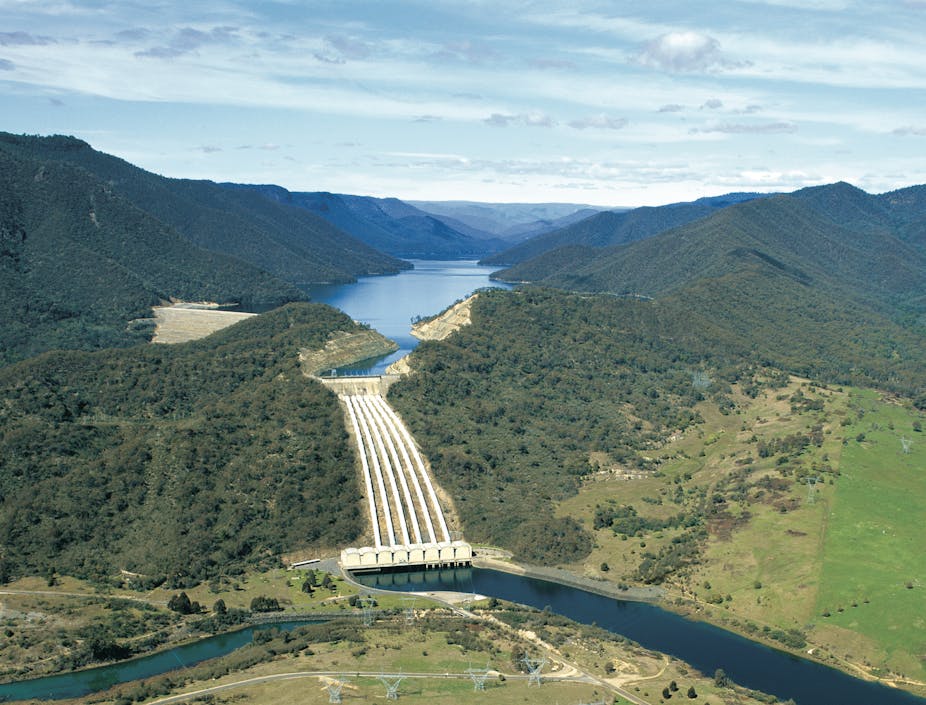Today’s carbon navel-gazing by politicians, business leaders and media scribes seems determined to constrain Australia to the stone age of industrial competence, workforce skills and international environmental policy.
Instead of talking so much about how we’ll reduce emissions, we could build the megawatts equivalent of one Snowy Mountain’s Scheme every year from now to 2050. Doing this would transform Australia to a fully renewable low carbon electricity and fuels system.
It would give us a revitalised industrial system based on doing difficult things at a scale commensurate with the low carbon challenge.
The laws of physics mean we have to rethink growth
In my work on this topic, I used a biophysical economics approach. This means national economic activities are constrained by the absolute physical laws of thermodynamics and mass balance.
This places a reality filter over the prospect of never-ending growth and unbridled technological optimism.
I found that equal shares of wind, solar PV, solar thermal and biomass generators could supply low carbon electricity, with most of the transition in place by 2040. Low carbon fuels were supplied from bio-alcohols made from purpose grown wood grown on nearly 60 million hectares of currently cleared farmland.
The immense physicality of the transition to renewables would be a huge stimulant to economic churn measures such as GDP.
This extra growth could be contained by the use of a sovereign wealth fund held outside the day-to-day workings of the domestic economy. This is similar to Norway’s Pension Fund, which invests petroleum revenues globally to avoid domestic demand and retain wealth for future generations.
If this extra growth was not constrained, additional consumption would drive a rebound in emissions. Technology penetration would be unable to keep up with economic growth and we would struggle to stabilise emissions.
Technology alone cannot rapidly reduce emissions to the five tonnes per capita or less required to stabilise atmospheric concentrations by 2050. Part of the solution is a low-growth economy.
The expense of renewables is a benefit
Conventional economics believes that price trumps everything. It says that economic churn and personal utility can grow without incident, once the economic settings are right and institutions set in order.
Biophysical economics holds that GDP represents the sum of specific energy transactions applied to value-adding activities in each economic sector. Energy is central and can’t be substituted.
So the task of decarbonising energy supplies is the essential one, rather than saving energy in a continually expanding system. (Perhaps de-carbonisation is helped a little by efficiency measures that lower the level of the pole-vault bar.)
This is why the high cost of renewable energy infrastructure is actually an advantage for our transition to renewable energy.
First, it requires huge physical transactions that stimulate GDP and employment.
Second, the scale of capital investment required restrains the opportunity for personal consumption and thus more emissions.
Third, it gives a tangible and valuable asset base that provides energy services for all Australians.
Our ever-expanding personal consumption must take a hit to help this happen. In physical terms, somewhere around half of our future expectations for the business-as-usual world out to 2050 must be ceded to the low carbon transition.
A new view of wealth
This represents a transfer from personal-wealth to a common-wealth. Cooperative ownership initiatives like the Hepburn Wind project in Victoria could allow each Australian to own gilt-edged capital assets and reap some rewards from the transition.
Industrialists rather than gamblers could become billionaires, provided they contribute to the transition, rather than claiming rents from the public purse.
A new technology breakthrough is not required here, although every little bit helps. My research used off-the-shelf technical specifications and today’s capital costs.
In conventional wisdom terms, renewables are inefficient. They are expensive concentrators of diffuse flows of wind, sun, water and plant growth. No breakthrough can rival the energy density of coal, oil, gas and nuclear.
But the advantages of this energy density and its combustion by-products form the core of today’s global challenges. Doing more of the same, even if a little better, will not turn the clock back.
A better way to invest
This transition will cost us, but doesn’t everything? In today’s money, the transition would cost $1,200 billion or 90% of the current stock of superannuation funds. The yearly spend of $25 billion represents one three-month period of growth increment in our national super, give or take a few global melt downs.
So how would you like your super spent: on a shopping mall, another brick veneer suburb, another commercial highrise in the CBD?
Or would you like Australia to lead the world with systems of low carbon electricity and transport fuels?
Would you like to revitalise our industrial base, to have green jobs replace black jobs, and have your grandchildren think that your nest egg helped make a difference?
Above all, we need to learn that today’s rules of economics cannot trump the absolute laws of physics.
In the end, thermodynamics and mass balance will rule.

